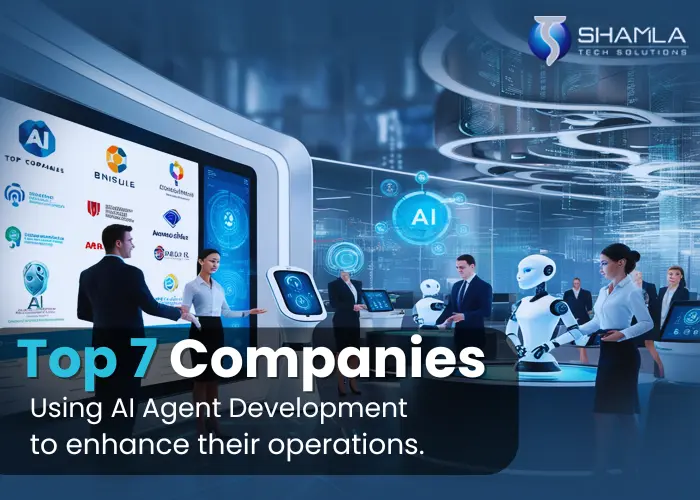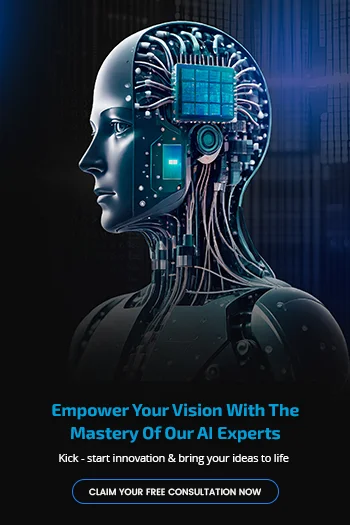AI agent development has become a key part of modern business, combining machine learning (ML), natural language processing (NLP), and deep reinforcement learning (DRL) to automate tasks, improve workflows, and help make decisions in real-time. Businesses use AI agent development solutions to improve efficiency, set up self-running systems, and grow smart customer interactions. These AI services help with predicting trends, spotting unusual patterns, and offering personalized suggestions, changing the way companies handle digital changes. As AI companies grow large-scale projects, industries like finance, healthcare, online shopping, and cybersecurity are using self-running AI systems more to make their work smoother and more efficient.
What Are AI Agents?
AI agents are self-running software programs made to do complex decision-making tasks by using machine learning models, natural language processing (NLP) tools, and real-time data analysis. These agents work through multi-part AI systems, combining both guided and unguided learning methods to process messy data, find patterns, and carry out set actions with little human help. AI agent development solutions help with smart automation in many fields, like customer service, where virtual assistants manage large numbers of questions, healthcare, where AI-based diagnostics improve medicine, and finance, where trading algorithms improve market plans. AI agent development services offer easy-to-use systems for businesses to set up flexible, self-learning systems that make work more efficient. AI agent development companies focus on teaching agents through learning and using transformer-based systems to improve their independence, helping with predictions and better decision-making in important tasks.
7 Companies Using AI Agent Development in their Operations
1. Google – Transforming Search and Virtual Assistance

Google has led the way in AI agent development by using advanced learning models in its search algorithms, allowing it to quickly understand searches, figure out context, and predict what users want. The use of RankBrain, a system based on neural networks, helps improve search results by looking at how words relate to each other and studying user behavior. BERT (Bidirectional Encoder Representations from Transformers) helps Google’s AI better understand natural language, making it able to handle complex, conversational questions almost like a human. Google’s search AI keeps getting better by learning from user interactions and large amounts of data, making search results more accurate based on user activity, the relevance of content, and how language changes over time.
Google Assistant is a great example of AI agent development, using top-notch speech recognition, text-to-speech, and deep learning to give personalized virtual help. With the LaMDA (Language Model for Dialogue Applications) framework, Google Assistant can handle multiple conversations with improved flow and memory. It works well with smart home devices, business tools, and customer service platforms, showing how scalable AI agents can be. By using federated learning, Google improves Assistant’s language skills without risking user privacy, making sure it adapts to the user in real-time while keeping data safe. These innovations make Google Assistant a leader in AI-driven, self-learning user interaction.
Besides serving consumers, Google has expanded its AI development to help businesses automate tasks and boost efficiency. Google Cloud AI connects pre-made models with AutoML tools, allowing companies to easily use AI for tasks like data analysis, detecting fraud, and automating document work with little human help. Tools like Dialogflow let companies build chatbots to answer customer questions and get helpful insights. By improving AI agent development solutions, Google continues to push the limits of machine intelligence, improving digital tools across industries with self-learning AI that drives efficiency and innovation.
2. Amazon – E-Commerce and Smart Homes

Amazon has changed the way it suggests products using its AI-powered recommendation system, which uses advanced methods to analyze user behavior in real-time and provide highly personalized product suggestions. By using powerful neural networks trained on large amounts of transaction data, this system can predict what customers are likely to buy, improve cross-selling, and keep customers coming back. AI services are connected to real-time processing through Amazon Personalize, a tool that changes suggestions based on browsing history, past purchases, and other relevant information. These AI insights not only help increase sales but also allow Amazon to predict demand better, reduce cart abandonment, and improve user engagement through focused marketing strategies across the Amazon platform.
Amazon Alexa is a big step forward in AI technology, using language processing, understanding of context, and edge AI to create a smart voice-controlled system. Built with Amazon’s own text-to-speech technology and supported by pre-trained models, Alexa keeps getting better at understanding speech, recognizing what users want, and handling ongoing conversations. AI speech enhancement tools help Alexa detect wake words more accurately and understand emotions, allowing it to give more accurate answers based on the situation. By connecting with smart home devices, Alexa’s AI agents can control appliances, save energy, and allow easy, voice-controlled interactions in different environments.
AI agents are also key in Amazon’s logistics and supply chain, where they help manage inventory using machine vision, learning from data, and real-time predictions. Amazon’s robots in warehouses use deep learning and vision tools to sort products automatically, reduce mistakes, and speed up processing. AI services also help with last-mile delivery by optimizing routes, guiding self-driving vehicles, and using drones for deliveries. By adding AI to logistics, customer service bots, and fraud detection systems, Amazon continues to improve its AI services to run things more efficiently, lower costs, and keep customers happy on a large scale.
3. Microsoft – Advancing Enterprise AI and Cloud Solutions

Microsoft has made itself a top AI agent development company through its strong Azure AI system, which brings together deep learning, natural language processing (NLP), and smart computing to power business solutions. Azure AI uses transformer-based systems, like OpenAI’s GPT models and Microsoft’s own Turing models, to improve language understanding, detect problems, and predict trends. AI agent development solutions within Azure Cognitive Services allow businesses to quickly turn speech, pictures, and text into useful information. These AI tools speed up cloud-based automation, improving business decisions and intelligence across many industries.
AI-powered automation is at the center of Microsoft’s business products, with AI agents making workflows simpler, cutting down on the need for human work, and improving efficiency. Azure Machine Learning combines AutoML, fine-tuning settings, and reinforcement learning to automatically handle data science tasks, making it easier for businesses to use predictive models. Microsoft Power Automate, which includes AI-driven robotic process automation (RPA), helps businesses organize repetitive tasks, handle documents, and get data smartly. AI development tools within Microsoft Dynamics 365 also improve customer management (CRM) by using AI to analyze feelings, detect fraud, and help chatbots provide a more personalized experience.
Microsoft’s cloud system powered by AI helps businesses process large amounts of data, allowing them to improve supply chain management, security, and risk assessments through smart analysis. AI agents in Azure Synapse Analytics use fast data processing and real-time query improvements to handle large-scale data tasks. Also, Microsoft’s AI for Business package uses deep learning to help businesses predict the future and adapt to changing situations, which helps reduce risks and grow profits. Microsoft keeps improving its AI solutions, helping businesses adopt AI easily across industries with advanced cloud services and smart automation systems.
4. Tesla – Enhancing Autonomous Driving and Robotics

Tesla’s AI-powered self-driving technology depends on deep learning systems, computer vision, and combining sensor data to process and understand complex information in real time. The Full Self-Driving (FSD) system uses a vision-based method, powered by Tesla’s own Dojo supercomputer, which helps speed up the training of AI models using high-performance computers. Tesla’s AI agent development uses special networks for detecting objects, analyzing patterns over time, and predicting movements to plan paths. By using AI services, Tesla constantly improves its self-learning models by collecting data from its entire fleet of cars, leading to steady improvements in navigation and hazard detection.
AI agents in Tesla’s Autopilot system help make smart decisions by processing large amounts of data from cameras, radar, and sensors. Reinforcement learning helps to plan paths in real time, adjusting speed, braking, and lane changes quickly and accurately. Tesla’s neural networks create 3D maps of the environment and use techniques that mimic human driving to reduce the chance of accidents. AI tools also help recognize pedestrians, cyclists, and road signs, improving awareness in busy city traffic. Tesla’s AI services use detailed maps and learning from multiple agents to help cars adapt to changing traffic without needing too much outside data.
Tesla also applies AI to robotics, as seen with its humanoid robot, Optimus. This robot uses special techniques to understand its body’s position and feedback, helping it perform tasks with high precision. Tesla’s AI-powered robots plan their movements using learning systems that improve motor skills and interactions. AI also helps robots understand their surroundings by combining data from multiple cameras and predicting what actions to take, allowing them to perform real-world tasks. Tesla’s ongoing work in AI and automation puts it at the forefront of both self-driving cars and robotics, continuously pushing forward the possibilities of machine intelligence and human-AI cooperation.
5. IBM – Leading AI in Enterprise and Healthcare

IBM has become one of the top companies in AI agent development through IBM Watson, a powerful AI platform designed for business applications like analytics and automation. Watson’s smart computing abilities use deep learning, natural language processing (NLP), and knowledge graphs to pull useful information from unorganized data, helping automate tasks in business operations. AI tools like Watson Orchestrate combine learning techniques and robotic process automation (RPA) to make workflows easier, reduce the need for human work, and improve how resources are planned in businesses. IBM’s AI services improve decision-making by helping businesses predict outcomes, process data in real-time, and spot unusual data patterns in critical tasks.
In the finance world, AI agents powered by IBM Watson help with risk analysis, fraud detection, and stock trading using smart decision-making models. Learning methods built into Watson’s system help predict financial outcomes by looking at past market data, transaction patterns, and economic signs. AI models help find fraud by using special tools that detect fake activities, making sure businesses follow changing rules. IBM’s AI services also power chatbots that provide financial advice, using sentiment analysis and NLP to give helpful financial insights that make customers feel more engaged and improve operations in banks and finance businesses.
IBM Watson’s healthcare solutions make use of different AI technologies, including tools for analyzing medical images, studying genes, and helping with diagnosing health issues. AI agents go through electronic health records (EHRs) using smart language models to spot disease patterns, predict patient results, and suggest treatment plans. Watson Health uses AI tools to read medical images like x-rays and find problems with great accuracy, supporting doctors’ decisions. IBM’s AI services are also speeding up drug research by using advanced AI techniques and powerful computers, changing the healthcare world by making things more automated and helping predict health outcomes.
6. Meta – Innovating AI in Social Media and Advertising

Meta has really taken content moderation to the next level with its AI-powered systems that use deep learning, computer vision, and natural language processing (NLP). The company’s moderation tools use neural networks (CNNs and RNNs) to find harmful or inappropriate content in real-time across text, images, and video. Meta’s AI agents use models and sentiment analysis to spot hate speech, misinformation, and graphic content. These systems are always being updated with feedback from users and learning to make smarter decisions. AI development solutions help Meta scale content moderation across billions of users around the world, making the platform safer.
In advertising, Meta uses AI agents to improve targeted ads using predictions, user behavior patterns, and personalized algorithms. The company’s ad system uses decision trees, filtering, and other algorithms to make ads more relevant and engaging. Meta’s AI agents process large amounts of data on people’s age, actions, and how they interact to create detailed audience groups, making sure ads reach the right customers. AI-driven ad optimization helps Meta give personalized ad experiences, which boosts sales and keeps people from getting tired of seeing the same ads. These systems are always getting better with A/B testing and looking at how users interact.
AI agents are very important in improving user interaction and keeping the platform secure. Meta’s AI systems monitor what users are doing, using techniques like autoencoders and grouping methods to spot security risks and fake activities. These agents look at how users act and flag things like fake accounts or coordinated actions. For user engagement, Meta’s AI-powered recommendation system suggests personalized content, using filtering and recommendation models to keep users coming back. Meta keeps pushing the limits of smart systems, making the platform safer and more engaging while also reaching important business goals.
7. OpenAI – Pioneering AI Agents in Conversational AI

OpenAI has been a leader in improving how computers understand and use language with its game-changing model, ChatGPT. This model uses special computer techniques like GPT-3 and GPT-4. These models learn from a lot of different text data to create answers that make sense and fit the situation. By using advanced ways of learning and multi-step deep learning methods, ChatGPT is very good at understanding and creating language that sounds like how people speak. OpenAI’s models also get better by learning from feedback from people, which helps them do tasks like translating languages, summarizing information, and having conversations. AI agent development systems like ChatGPT show just how powerful deep learning is in making smart systems that can have detailed conversations.
AI agents that use OpenAI’s models are changing customer support by taking over tasks like solving ticket issues, answering common questions, and helping with live chats. These smart agents understand the meaning of words, the situation, and what people want to know, so they can give quick and helpful answers. In customer service, AI agents look at a lot of different types of data to help people by giving the right answers and solutions. These agents can also learn without needing specific training for every topic, which lowers costs and makes the service faster. OpenAI’s AI agent services help businesses create virtual assistants that can work around the clock, always available to help customers.
AI agents are also changing the way content is created in many fields by automatically making written content, social media posts, and even code. OpenAI’s GPT models help content creators quickly write drafts, improve existing writing, and even make creative content that fits the needs of specific people. By learning about specific topics, these AI agents can create content that fits the right style and tone, saving time and effort. As part of OpenAI’s AI services, these systems work easily with digital marketing, journalism, and software development, speeding up work and improving creativity.
Conclusion
The future potential of AI agents is in their ability to make automation even better, change customer service by using smart interaction, and make decision-making easier by processing huge amounts of data to get quick insights. Their ability to learn and change will make things more efficient and effective in every industry. Businesses should look into AI agent development solutions to stay competitive, improve how they work, and bring in new ideas. By adding AI to business processes, companies can have better workflows, happier customers, and make smarter decisions.
Shamla Tech is an AI agent development company specializing in delivering advanced and innovative AI agent development services. Through our AI agent development solutions, we’ve helped numerous businesses automate their operations, leading to significant improvements in productivity, cost savings, and overall success. With expertise in NLP, machine learning, and intelligent automation, we enable scalable AI-driven transformation.


